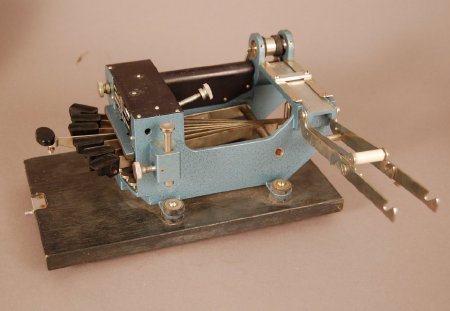Object ID:
2002.26
Title:
Model J Braille Shorthand Writer
Description:
(a) Cast aluminum frame, enameled crackled blue; stamped aluminum housing, enameled black, wrapped around top of keyboard on front and around paper tape advance roller on left; folding nickel plated paper reel arm on back right; a secondary tape roller extends from the base of the reel arm; (paper tape reel stores in threaded hole in plate behind the keyboard housing); six cupped black plastic, rectilinear keys and a spacing key in the middle with its oval pad set perpendicular to the other keys; round padded rests under each key and a padded bar is set above the key arms; nickel-plated brass paper tape advance knob above and to left of keyboard, extending back to a pair of spring loaded rollers on the back left of the frame; no paper tape reel end bell, it has been omitted on this model; stamped into housing above keyboard, "Model J No. 057 Ernest F. Moy Ltd. Royal National Institute For The Blind London England"; four feet on braillewriter bolted to removable wood base each insulated with two rubber washers; base painted black; (b) wooden carrying case fits over base and latches on end with a nickel plated spring latch; case is covered with a dark charcoal gray leatherette; black plastic handle on top.
Date:
ca. 1977
Made by:
Ernest F. Moy Ltd.
Place of Origin:
England
Provenance:
Henry Stainsby (1859-1925), Supt. of the Birmingham Royal Institution for the Blind, along with Birmingham manufacturer Albert Wayne patented a braille shorthand machine in 1899-1900. His tapewriter was developed as a note-taking tool for blind stenographers being trained at Birmingham. Stainsby's goal was employment for his students. By the 1920s, the Stainsby-Wayne Braille Shorthand Writer was being sold by the National Institute for the Blind. A number of versions followed, with a major change with the introduction of the Stainsby "F" in 1947-48. This version, the J, is descended from the Model F and was available by 1977.

